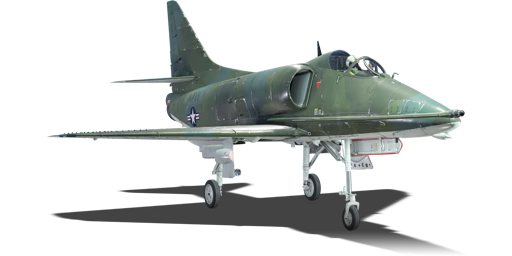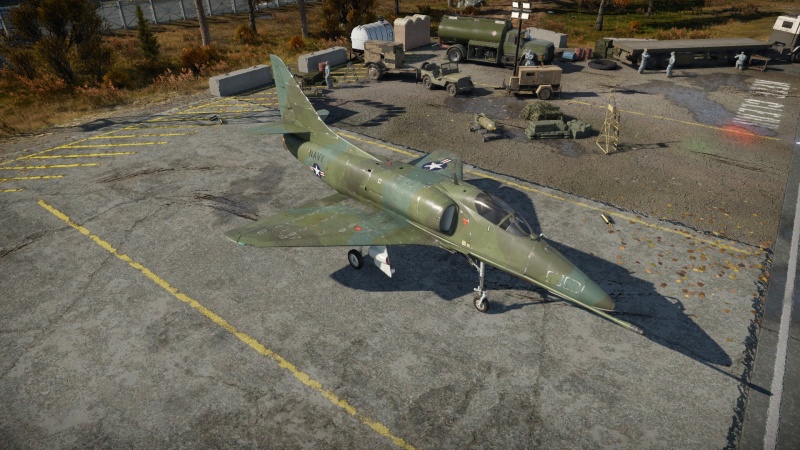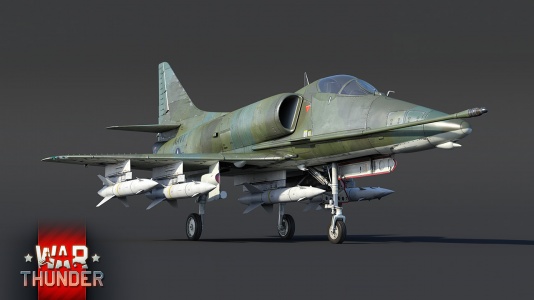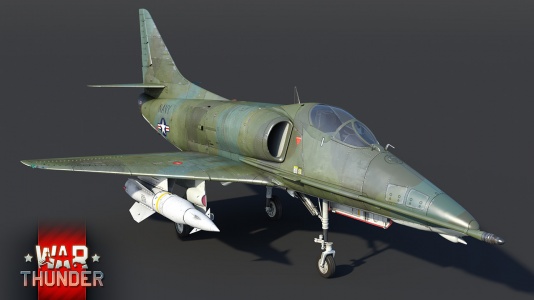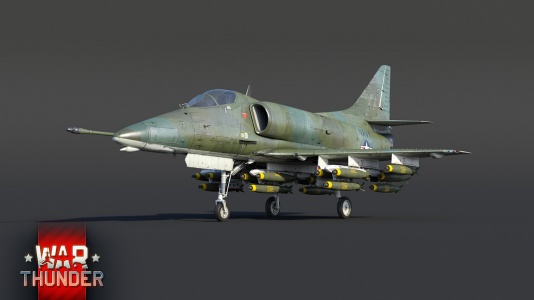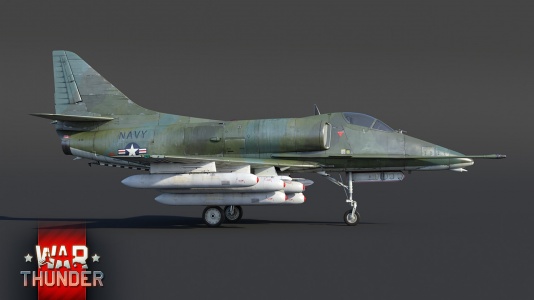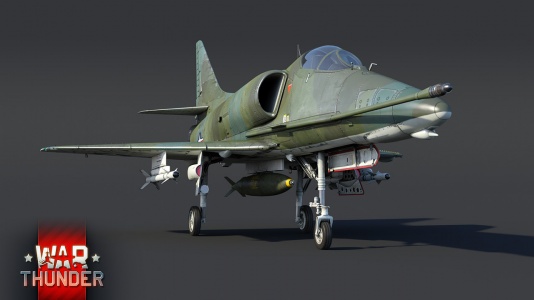Difference between revisions of "A-4E Early"
m (A few vocabulary issues I noted (phrases, terms)) (Tag: Visual edit) |
(→Usage in battles: Updated with vastly more detail for play style. →Flight Performance: Updated to include details on how to prevent wing tear.) (Tag: Visual edit) |
||
| Line 62: | Line 62: | ||
|- | |- | ||
|} | |} | ||
| + | Wings are well-known to be fragile and to easily tear at normal speeds. To prevent this, always pitch positive relative to the wing. Pitching negative, or yawing too violently, are easy ways to rip one or both of your wingtips. Use the plane's high role rate to your advantage, and make it a habit to always bank into your turns. | ||
{| class="wikitable" style="text-align:center" | {| class="wikitable" style="text-align:center" | ||
| Line 194: | Line 195: | ||
== Usage in battles == | == Usage in battles == | ||
<!-- ''Describe the tactics of playing in the aircraft, the features of using aircraft in a team and advice on tactics. Refrain from creating a "guide" - do not impose a single point of view, but instead, give the reader food for thought. Examine the most dangerous enemies and give recommendations on fighting them. If necessary, note the specifics of the game in different modes (AB, RB, SB).'' --> | <!-- ''Describe the tactics of playing in the aircraft, the features of using aircraft in a team and advice on tactics. Refrain from creating a "guide" - do not impose a single point of view, but instead, give the reader food for thought. Examine the most dangerous enemies and give recommendations on fighting them. If necessary, note the specifics of the game in different modes (AB, RB, SB).'' --> | ||
| − | In Air Realistic battles, one can | + | In Air Realistic battles, one can use this plane in a wide array of roles due to the wide array of armament. |
| − | In Ground RB, the preferable secondary armaments are the [[FFAR Mighty Mouse|FFAR]] or [[Zuni Mk32 Mod 0 ATAP|Zuni]] rocket pods, or the 5 x [[AGM-12B Bullpup|AGM-12B]] missiles. These missiles, with enough practice, function like a precision 250 lb bomb that is guided to the target, most of the time destroying it. The A-4E can be well paired with the [[XM-803]], [[MBT-70]], | + | The first path is as an air-to-air fighter. The A-4E can equip either the 2 x [[AIM-9B Sidewinder]]s, the 2 x [[AIM-9B Sidewinder|AIM-9Bs]] and the 20 mm gunpod, or a triple gunpods for this role. The A-4E's standard 20mm cannons can easily shred any plane in the sky with a handful of well-placed rounds, however it only comes with 200 bullets, so short controlled bursts must be used, and only should be fired sparingly. The missiles can easily supplement the cannon, however these early missiles have a narrow tracking cone, and can easily miss targets that fly erratically, so they too must be used sparingly. If one prefers to be a gun fighter, a single gunpod (or three) can be attached to spray down targets, however they drag down the plane's climb and turn performance (especially the triple gun pods, which eliminate this plane's climbing ability in a fight). |
| + | |||
| + | General tactics with the A-4E is to keep altitude until one finds a target to pounce on, preferably fighters trying to climb, low flying aircraft, or distracted aircraft. The attacker air spawn will give you an advantage on your ascent to altitude, preferably to 5,000 - 6,000 meters. Always attempt to fight aircraft flying alone; Attacking an aircraft within a group is risky, as your low energy retention will make it hard to escape if the attack goes unfavorably. It is also best to turn off if the attacker starts to evade; If you try to chase, you can quickly bleed energy. However, when uptiered, especially versus planes like the British [[Harrier GR.1]], fighting offensively may not work at all, as these planes can easily out climb and out run you, and they will bounce you. In cases like these, it is best to stay back and play as a supporting fighter to your team, or simply switch to ground attack roles. | ||
| + | |||
| + | Your best defense is to not engage in fights where you are clearly outnumbered. However, if you are chased, there are little options for evasive maneuvering. The plane's high roll rate will make it incredibly easy to dodge bullets, and the flares will help the plane dodge missiles. However, the low energy retention will make it extremely hard to escape the fight altogether, especially if perused by multiple aircraft. In such situations, your best bet is to have a friendly plane to pounce the chasing enemy fighters, which can give you a window to escape or fight back. | ||
| + | |||
| + | If using this place as a ground attacker, equip either [[FFAR Mighty Mouse|FFAR]] or [[Zuni Mk32 Mod 0 ATAP|Zuni]] rocket pods or [[AGM-12B Bullpup|AGM-12]] Bullpups, and attack ground targets. Another option is to use the wide array of bombs, preferably the 14 x 500 lb loadout, and destroy enemy bases (typically you can only destroy one, sometimes two) with them. Then, when you return to base, you could rearm with bombs, or rearm with [[AIM-9B Sidewinder|AIM-9's]] and fly as a late-game fighter to finish off remaining players. | ||
| + | |||
| + | In Ground RB, the preferable secondary armaments are the [[FFAR Mighty Mouse|FFAR]] or [[Zuni Mk32 Mod 0 ATAP|Zuni]] rocket pods, or the 5 x [[AGM-12B Bullpup|AGM-12B]] missiles. These missiles, with enough practice, function like a precision 250 lb bomb that is guided to the target, most of the time destroying it. The 2 x AGM-62A Walleye bombs can also be used very effectively with practice, however with only two bombs, it is better to use the five [[AGM-12B Bullpup|AGM-12B]] missiles instead. The A-4E can be well paired with the [[XM-803]], [[MBT-70]], or the [[XM-1 (GM)|XM-1]] to form a good lineup. | ||
=== Pros and cons === | === Pros and cons === | ||
| Line 207: | Line 216: | ||
* Researchable flares are a good counter to IR guided missiles it may face at its BR | * Researchable flares are a good counter to IR guided missiles it may face at its BR | ||
* [[AGM-12B Bullpup]] is a tier I modification | * [[AGM-12B Bullpup]] is a tier I modification | ||
| − | * Can use | + | * Can use air spawn and play in a fighter role |
* High roll rate | * High roll rate | ||
Revision as of 21:17, 28 January 2022
| This page is about the American strike aircraft A-4E Early. For other versions, see A-4 (Family). |
Contents
Description
The A-4E Skyhawk Early is a squadron rank VI American strike aircraft with a battle rating of 9.0 (AB), 8.7 (RB), and 9.3 (SB). It was introduced during Update "New Power".
General info
Flight performance
The A-4E behaves like the A-4B, with excellent manoeuvrability at speed, aided by the automatic wing slats. However, the aircraft's poor energy retention during turns is profound, and airspeed will drop down to about 320 km/h (200 mph) after more than a 90 degree turn. Overall, it can turn with G.91s and MiG-15s without issue, however extended dogfights should be avoided. If uptiered, flight performance leaves much to be desired, it can be outmanoeuvred even by the Yak-38 or F-104 in a dogfight.
| Characteristics | Max Speed (km/h at 0 m - sea level) |
Max altitude (metres) |
Turn time (seconds) |
Rate of climb (metres/second) |
Take-off run (metres) | |||
|---|---|---|---|---|---|---|---|---|
| AB | RB | AB | RB | AB | RB | |||
| Stock | 1,066 | 1,057 | 12500 | 37.9 | 39.0 | 29.5 | 26.7 | 900 |
| Upgraded | 1,096 | 1,081 | 36.5 | 37.0 | 51.4 | 40.0 | ||
Details
| Features | |||||
|---|---|---|---|---|---|
| Combat flaps | Take-off flaps | Landing flaps | Air brakes | Arrestor gear | Drogue chute |
| ✓ | ✓ | ✓ | ✓ | ✓ | X |
| Limits | ||||||
|---|---|---|---|---|---|---|
| Wings (km/h) | Gear (km/h) | Flaps (km/h) | Max Static G | |||
| Combat | Take-off | Landing | + | - | ||
| 1167 | 437 | 592 | 562 | 410 | ~8 | ~3 |
Wings are well-known to be fragile and to easily tear at normal speeds. To prevent this, always pitch positive relative to the wing. Pitching negative, or yawing too violently, are easy ways to rip one or both of your wingtips. Use the plane's high role rate to your advantage, and make it a habit to always bank into your turns.
| Optimal velocities (km/h) | |||
|---|---|---|---|
| Ailerons | Rudder | Elevators | Radiator |
| < 450 | < 700 | < 490 | N/A |
Engine performance
| Engine | Aircraft mass | ||||||
|---|---|---|---|---|---|---|---|
| Engine name | Number | Basic Mass | Wing loading (full fuel) | ||||
| Pratt & Whitney J52-P-6A | 1 | 4,679 kg | 296 kg/m2 | ||||
| Engine characteristics | Mass with fuel (no weapons load) | Max Takeoff Weight | |||||
| Weight (each) | Type | 12m fuel | 20m fuel | 30m fuel | 40m fuel | ||
| 900 kg | Axial-flow turbojet | 5,419 kg | 5,913 kg | 6,530 kg | 7,147 kg | 11,113 kg | |
| Maximum engine thrust @ 0 m (RB / SB) | Thrust to weight ratio @ 0 m (100%) | ||||||
| Condition | 100% | WEP | 12m fuel | 20m fuel | 30m fuel | 40m fuel | MTOW |
| Stationary | 3,470 kgf | N/A | 0.64 | 0.59 | 0.53 | 0.49 | 0.31 |
| Optimal | 3,470 kgf (0 km/h) |
N/A | 0.64 | 0.59 | 0.53 | 0.49 | 0.31 |
Survivability and armour
- 2.54 mm steel surrounding bottom half of the pilot
- 50 mm bulletproof glass in front of the cockpit
The front half of the plane holds the pilot and a self-sealing fuel tank. The wings hold non self-sealing fuel tanks, and the back half of the plane holds the engine.
One single well-placed round from an ADEN cannon can completely cripple the plane by taking out the pilot or an engine. It is completely open to attack from the side and front although it can be armed with flares. Overall, survivability is quite poor, and players should minimize their chance of being hit.
Modifications and economy
Armaments
| Ballistic Computer | |||
|---|---|---|---|
| CCIP (Guns) | CCIP (Rockets) | CCIP (Bombs) | CCRP (Bombs) |
| |
|
|
|
Offensive armament
The A-4E Early is armed with:
- A choice between two presets:
- 2 x 20 mm Browning-Colt Mk12 Mod 0 cannons, wing-mounted (100 rpg = 200 total)
- 2 x 20 mm Browning-Colt Mk12 Mod 0 cannons + 60 x countermeasures
Suspended armament
The A-4E Early can be outfitted with the following ordnance:
- Without load
- 3 x 20 mm Mk 11 mod 5 cannons (750 rpg = 2,250 total)
- 20 x 250 lb LDGP Mk 81 bombs (5,000 lb total)
- 14 x 500 lb LDGP Mk 82 bombs (7,000 lb total)
- 3 x 750 lb M117 cone 45 bombs (2,250 lb total)
- 1 x 750 lb M117 cone 45 bomb (750 lb total) + 114 x FFAR Mighty Mouse rockets
- 1 x 750 lb M117 cone 45 bomb (750 lb total) + 24 x Zuni Mk32 Mod 0 ATAP rockets
- 1 x 750 lb M117 cone 45 bomb (750 lb total) + 4 x AGM-12B Bullpup missiles
- 1 x 750 lb M117 cone 45 bomb (750 lb total) + 2 x AIM-9B Sidewinder missiles
- 5 x 1,000 lb LDGP Mk 83 bombs (5,000 lb total)
- 1 x 2,000 lb LDGP Mk 84 bomb (2,000 lb total)
- 5 x AGM-12B Bullpup missiles
- 2 x AGM-12C Bullpup missiles
- 171 x FFAR Mighty Mouse rockets
- 36 x Zuni Mk32 Mod 0 ATAP rockets
- 2 x AIM-9B Sidewinder missiles
- 114 x FFAR Mighty Mouse rockets + 6 x 250 lb LDGP Mk 81 bombs (1,500 lb total)
- 114 x FFAR Mighty Mouse rockets + 6 x 500 lb LDGP Mk 82 bombs (3,000 lb total)
- 24 x Zuni Mk32 Mod 0 ATAP rockets + 6 x 250 lb LDGP Mk 81 bombs (1,500 lb total)
- 24 x Zuni Mk32 Mod 0 ATAP rockets + 6 x 500 lb LDGP Mk 82 bombs (3,000 lb total)
- 2 x AGM-12B Bullpup missiles + 133 x FFAR Mighty Mouse rockets
- 2 x AGM-12B Bullpup missiles + 28 x Zuni Mk32 Mod 0 ATAP rockets
- 2 x AGM-12B Bullpup missiles + 18 x 250 lb LDGP Mk 81 bombs (4,500 lb total)
- 2 x AGM-12B Bullpup missiles + 12 x 500 lb LDGP Mk 82 bombs (6,000 lb total)
- 2 x AGM-12B Bullpup missiles + 3 x 1,000 lb LDGP Mk 83 bombs (3,000 lb total)
- 2 x AIM-9B Sidewinder missiles + 8 x 250 lb LDGP Mk 81 bombs (2,000 lb total)
- 2 x AIM-9B Sidewinder missiles + 8 x 500 lb LDGP Mk 82 bombs (4,000 lb total)
- 2 x AIM-9B Sidewinder missiles + 3 x 1,000 lb LDGP Mk 83 bombs (3,000 lb total)
- 2 x AIM-9B Sidewinder missiles + 1 x 2,000 lb LDGP Mk 84 bomb (2,000 lb total)
- 2 x AIM-9B Sidewinder missiles + 3 x AGM-12B Bullpup missiles
- 2 x AIM-9B Sidewinder missiles + 95 x FFAR Mighty Mouse rockets
- 2 x AIM-9B Sidewinder missiles + 20 x Zuni Mk32 Mod 0 ATAP rockets
- 2 x AIM-9B Sidewinder missiles + 1 x 20 mm Mk 11 mod 5 cannon (750 rpg)
- 2 x 505 kg AGM-62A Walleye I bombs (1,010 kg total)
- 2 x 505 kg AGM-62A Walleye I bombs + 6 x 250 lb LDGP Mk 81 bombs (2,510 lb total)
- 2 x 505 kg AGM-62A Walleye I bombs + 6 x 500 lb LDGP Mk 82 bombs (4,010 lb total)
- 2 x 505 kg AGM-62A Walleye I bombs + 1 x 750 lb M117 cone 45 bomb (1,760 lb total)
- 2 x 505 kg AGM-62A Walleye I bombs + 3 x 1,000 lb LDGP Mk 83 bombs (4,010 lb total)
Usage in battles
In Air Realistic battles, one can use this plane in a wide array of roles due to the wide array of armament.
The first path is as an air-to-air fighter. The A-4E can equip either the 2 x AIM-9B Sidewinders, the 2 x AIM-9Bs and the 20 mm gunpod, or a triple gunpods for this role. The A-4E's standard 20mm cannons can easily shred any plane in the sky with a handful of well-placed rounds, however it only comes with 200 bullets, so short controlled bursts must be used, and only should be fired sparingly. The missiles can easily supplement the cannon, however these early missiles have a narrow tracking cone, and can easily miss targets that fly erratically, so they too must be used sparingly. If one prefers to be a gun fighter, a single gunpod (or three) can be attached to spray down targets, however they drag down the plane's climb and turn performance (especially the triple gun pods, which eliminate this plane's climbing ability in a fight).
General tactics with the A-4E is to keep altitude until one finds a target to pounce on, preferably fighters trying to climb, low flying aircraft, or distracted aircraft. The attacker air spawn will give you an advantage on your ascent to altitude, preferably to 5,000 - 6,000 meters. Always attempt to fight aircraft flying alone; Attacking an aircraft within a group is risky, as your low energy retention will make it hard to escape if the attack goes unfavorably. It is also best to turn off if the attacker starts to evade; If you try to chase, you can quickly bleed energy. However, when uptiered, especially versus planes like the British Harrier GR.1, fighting offensively may not work at all, as these planes can easily out climb and out run you, and they will bounce you. In cases like these, it is best to stay back and play as a supporting fighter to your team, or simply switch to ground attack roles.
Your best defense is to not engage in fights where you are clearly outnumbered. However, if you are chased, there are little options for evasive maneuvering. The plane's high roll rate will make it incredibly easy to dodge bullets, and the flares will help the plane dodge missiles. However, the low energy retention will make it extremely hard to escape the fight altogether, especially if perused by multiple aircraft. In such situations, your best bet is to have a friendly plane to pounce the chasing enemy fighters, which can give you a window to escape or fight back.
If using this place as a ground attacker, equip either FFAR or Zuni rocket pods or AGM-12 Bullpups, and attack ground targets. Another option is to use the wide array of bombs, preferably the 14 x 500 lb loadout, and destroy enemy bases (typically you can only destroy one, sometimes two) with them. Then, when you return to base, you could rearm with bombs, or rearm with AIM-9's and fly as a late-game fighter to finish off remaining players.
In Ground RB, the preferable secondary armaments are the FFAR or Zuni rocket pods, or the 5 x AGM-12B missiles. These missiles, with enough practice, function like a precision 250 lb bomb that is guided to the target, most of the time destroying it. The 2 x AGM-62A Walleye bombs can also be used very effectively with practice, however with only two bombs, it is better to use the five AGM-12B missiles instead. The A-4E can be well paired with the XM-803, MBT-70, or the XM-1 to form a good lineup.
Pros and cons
Pros:
- Can be armed with 5 AGM-12B Bullpup missiles
- Has loadouts with AIM-9B Sidewinder missiles to either defend itself or play the role of a fighter
- Researchable flares are a good counter to IR guided missiles it may face at its BR
- AGM-12B Bullpup is a tier I modification
- Can use air spawn and play in a fighter role
- High roll rate
Cons:
- Subsonic
- Mediocre climb rate compared to planes it can face
- AIM-9B Sidewinder missiles are tier III modifications
- Gun pods are tier IV modifications
- Stock armament of just 2 x 20 mm cannons with minimal ammunition makes for a hard stock grind
- Using the the Walleye TV-guided bomb requires you to fly straight toward enemies and expose your aircraft to retaliatory fire (SAMs)
History
The A4D-5 Skyhawk was an improved model of the A4D-2N (designated A-4C in 1962). The main improvement came in the form of the more powerful Pratt & Whitney J52-P-6A engine, producing 8,400 pounds of thrust. In addition to the new powerplant, the A4D-5 also received two more wing-mounted stores pylons, for a total of five. The avionics were also improved, including a new TACAN system and a toss-bombing computer. Later in their service life, many A-4E Skyhawks were upgraded with the fuselage avionics pod J52-P-8 engine (with 9,300 pounds of thrust) from the A-4F.
The A4D-5 first flew in July 1961, and was renamed to A-4E in 1962 after the Tri-Service Aircraft Designation System came into effect. The A-4E entered production in December of 1962; a total of 499 A-4E Skyhawks would be delivered to the US Navy and Marine Corps starting in January 1963.
The A-4E began to see combat in Vietnam after arriving in early 1965, but it did not fully replace the earlier Skyhawks such as the A-4C. After opening in June 1965, the Chu Lai Short Airfield for Tactical Support (SATS) housed Marine A-4E Skyhawks. The Skyhawks landed using arrestor wires and took off by rocket-assisted takeoff (RATO). Throughout the Vietnam War, A-4 Skyhawks were used to provide close air support (CAS) for Marine Corps ground forces, primarily using bombs and rockets. A total of 362 A-4s of all types were lost during the Vietnam War, including non combat losses. 271 were from the US Navy, and 91 were from the Marine Corps.
During the war, many A-4Es and A-4Fs were used in the United States for training purposes. They had their armament - including external stores - removed and their slats fixed, and were used as aggressors (where they would act as enemy aircraft for training). In the aggressor role, an A-4 was called 'Mongoose'.
- 1965 Philippine Sea Incident
It was December 5, 1965. This was the time of the Cold War and Vietnam War. Sailing 70 miles from the nearest island, 200 miles from Okinawa, was the USS Ticonderoga, carrying Attack Squadron 56 (VA-56) consisting of A-4E attack jets that were carrying nuclear bombs. Lieutenant (Junior Grade) Douglas M. Webster, pilot of Douglas A-4E BuNo 151022 was performing a training exercise in his jet, rolling from hangar 2 to elevator 2. The jet was carrying a one megaton B43 thermonuclear bomb. An unspecified accident occurred, and the jet rolled off the deck. After a search, neither the pilot, the jet, nor the bomb was ever found, they likely sank the 16,000 ft (4,900 m) to the ocean floor. This was just one of the many "broken arrow" incidents during the Cold War.
The incident was acknowledged in 1981, but was misleading and it was fully revealed in 1989 due to a diplomatic inquiry by Japan. Lt. Cmdr. James Culda said on May 8, 1989 that "the environmental impact is expected to be nil", as the bomb was not armed and poses no threat at 4,900 m under the sea.
Devblog
The beginning of the jet era and the escalation of the Cold War forced the US naval aviation command to look for a replacement for the very successful carrier-based piston-engine AD Skyraider, with the possibility of delivering a tactical nuclear weapon in the area of operation of an aircraft carrier group. With the beginning of the military campaign in Korea, the Douglas Aircraft Company began developing a carrier-based attack aircraft with an unconventional approach - instead of pursuing engine power, usually bringing weight and large size to the aircraft, Ed Heinemann's team concentrated on finding ways to lighten the construction, keeping it under 12,000 lbs.
The projected aircraft was a fairly compact, lightweight jet fighter-attacker with a delta-shaped wing and a competently lightweight design. This is how the A-4A Skyhawk was born, one of the first jet-based carrier-based aircraft capable of carrying a nuclear bomb. The aircraft was distinguished by its simplicity of design, practical controls with excellent flight characteristics for its time. Soon, in 1956, the A-4B version appeared, capable of carrying a huge variety of mounted weapons on three suspension points, including guided missiles.
Thus, "Skyhawk" had become a truly universal carrier-based aircraft, capable of solving the entire spectrum of tasks for US Naval Aviation. A rather noticeable drawback of the attack aircraft was still the limited range of action, also army types always wanted to increase the weapon load. In 1961, Douglas presented an improved version of the aircraft with five pylons for armament and a new engine, which compensated for a heavier combat load, and also increased the range of the attack aircraft. It was the A-4E that became one of the most massive Skyhawk modifications and formed the image of a modern carrier-based attack aircraft. The "E" version was actively involved in the Vietnam War, and later, up till the end of the 80's, was used to simulate enemy aircraft in training dogfights.
Media
- Skins
- Images
- A-4E Early Devblog Images
- Videos
See also
Links to the articles on the War Thunder Wiki that you think will be useful for the reader, for example:
- reference to the series of the aircraft;
- links to approximate analogues of other nations and research trees.
External links
- [Devblog] A-4E Skyhawk: Heinemann's Hot-Rod grows up
- Official data sheet - more details about the performance
- Standard Aircraft Characteristics of the A-4E
References
- Bibliography
- A-4E Skyhawk: Pacific Coast Air Museum: Navy Attack Plane. (2019, December 17). Retrieved December 12, 2020, from https://pacificcoastairmuseum.org/aircraft/a-4e-skyhawk/
- A-4 Skyhawk Production. (n.d.). Retrieved December 12, 2020, from http://skyhawk.org/content/douglas-4-skyhawk-production-history
- Standard Aircraft Characteristics Navy Model A-4E Aircraft. (n.d.). Retrieved from http://www.alternatewars.com/SAC/A-4E_Skyhawk_SAC_-_1_July_1967.pdf
| Douglas Aircraft Company | |
|---|---|
| Strike Aircraft | A-20G-25 · A-26B-10 · A-26B-50 · AD-2 · AD-4 · A-1H |
| Bombers | TBD-1 · B-18A · SBD-3 · BTD-1 · A-26C-45 · A-26C-45DT |
| Turboprops | A2D-1 |
| Jet Aircraft | F3D-1 · F4D-1 |
| A-4 Skyhawk | A-4B · A-4E Early |
| Export | ▄Havoc Mk I · ▄Boston Mk I · ▄DB-7 · ▂A-20G-30 · ▄AD-4 · ▄AD-4NA |
| A-4 Skyhawk | A-4H · A-4E Early (M) · Ayit · A-4E |
| The Douglas Aircraft Company merged with McDonnell Aircraft Corporation in 1967 to form McDonnell Douglas. | |
| USA jet aircraft | |
|---|---|
| Fighters | |
| F9F | F9F-2 · F9F-5 · F9F-8 |
| F-80 | F-80A-5 · F-80C-10 |
| F-84 | F-84B-26 · F-84F · F-84G-21-RE |
| F-86 | F-86A-5 · F-86F-25 · F-86F-2 · F-86F-35 |
| F-89 | F-89B · F-89D |
| F-100 | F-100D |
| F-104 | F-104A · F-104C |
| F-4 | F-4C Phantom II · F-4E Phantom II · F-4J Phantom II · F-4S Phantom II |
| F-5 | F-5A · F-5C · F-5E · F-20A |
| F-8 | F8U-2 · F-8E |
| F-14 | F-14A Early · ▄F-14A IRIAF · F-14B |
| F-15 | F-15A · F-15C MSIP II · F-15E |
| F-16 | F-16A · F-16A ADF · F-16C |
| Other | P-59A · F2H-2 · F3D-1 · F3H-2 · F4D-1 · F11F-1 |
| Strike Aircraft | |
| FJ-4 | FJ-4B · FJ-4B VMF-232 |
| A-4 | A-4B · A-4E Early |
| A-7 | A-7D · A-7E · A-7K |
| AV-8 | AV-8A · AV-8C · AV-8B Plus · AV-8B (NA) |
| A-10 | A-10A · A-10A Late · A-10C |
| F-111 | F-111A · F-111F |
| Other | A-6E TRAM · F-105D · F-117 |
| Bombers | |
| B-57 | B-57A · B-57B |
| Squadron aircraft | |
|---|---|
| USA | A-4E Early · F-117 |
| Germany | Me 262 A-1a/U1 · ◌Hunter F.58 |
| USSR | Su-22M3 |
| Britain | Firecrest · Sea Harrier FRS.1 |
| Japan | ▄F-5E FCU |
| China | JF-17 |


